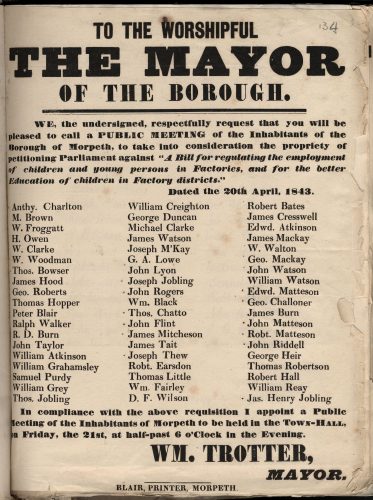Printed notice about meeting to discuss factory bill, 1843
Reference: SANT/BEQ/28/1/5/134
Suggested age groups: KS3, KS4, Lifelong Learners
Subject areas: History, Literacy, Politics, Technology
CONTEXT
In 1840 Parliament set up the Children’s Employment Commission. The aim of the Commission was to investigate the working conditions of children under the age of 18. As well as reporting on the conditions of children working in mines, the Commission also questioned children working in factories.
Many children were interviewed for the Commission. They were asked about their working hours, the conditions, if they had been ill and if they could read and write. The Commission found that many of the children did not go to school. Lots of the children that they talked to could not read and write properly.
Sir James Graham put a Bill before parliament (made a suggestion for an Act) that would set up schools for children working in factories and make sure that children had the time to go to lessons. This Bill, which is mentioned in the notice, was not made into law.
This poster asks people to come to a meeting to sign a petition against the Bill.
ACTIVITIES
ACTIVITY 1
Background
In 1840 Parliament set up the Children’s Employment Commission. The aim of the Commission was to investigate the working conditions of children under the age of 18. As well as reporting on the conditions of children working in mines, the Commission also questioned children working in factories.
SEE
See: When did Parliament set up the Children’s Employment Commission?
See: What was the aim of the Children’s Employment Commission?
See: Who did the Commission interview?
See: What types of questions did the Commission ask?
See: What were the findings of the Commission’s interviews?
THINK
Think: Why was the Children’s Employment Commission set up?
Think: Why were children used as factory workers?
Think: What types of jobs did the children do in factories?
Think: What types of conditions did the children work in?
Think: What types of backgrounds do you think the children who worked in factories came from?
Think: Why couldn’t many of the children read or write?
Think: How much do you think the children earned?
Think: Do you think any changes were made because of the Children’s Employment Commission?
DO
Do: Imagine you are conducting interviews for the Children’s Employment Commission with factory children. Write a list of questions that you would ask the children about their working conditions and experience in the factory.
Do: In pairs, interview each other as though you are a factory child and an interviewer for the Children’s Employment Commission.
Do: Research the Report on Child Labour 1842. Create a presentation showing the findings of the report and the short- and long-term outcomes.
Do: Look at the poems “A Voice from the Factories” – Caroline Sheridan Norton (1836) and “Cry of the Children” – Elizabeth Barrett Browning (1843). What do the poems tell you about child labour and the poet’s views on factory children? How did poetry raise awareness of the issue and contribute to change?
Do: Write your own poem condemning child labour inspired by Caroline Sheridan Norton, Elizabeth Barrett Browning and the Children’s Employment Commission Reports.
Resources
https://www.bl.uk/collection-items/factory-children-a-short-description-of-the-factory-system
https://www.bl.uk/collection-items/the-life-and-adventures-of-michael-armstrong-the-factory-boy
https://www.bl.uk/collection-items/report-on-child-labour-1842
https://www.poetryfoundation.org/poems/43725/the-cry-of-the-children
https://www.bl.uk/works/the-cry-of-the-children
https://digital.library.upenn.edu/women/norton/avftf/avftf.html
ACTIVITY 2
Background
Sir James Graham put a Bill before parliament (made a suggestion for an Act) that would set up schools for children working in factories and make sure that children had the time to go to lessons. This Bill, which is mentioned in the notice, was not made into law.
SEE
See: Who put the factory Bill before Parliament?
See: What does it mean to put a Bill before Parliament?
See: What did the factory Bill propose to do?
See: Was the Bill made into law?
THINK
Think: Why did the inhabitants of Morpeth want the Mayor to call a public meeting?
Think: What would the inhabitants of Morpeth have discussed at the meeting?
Think: Do you think the inhabitants of Morpeth would have been for or against the Bill?
Think: Why did so many people sign the printed notice asking for the meeting to take place?
Think: Why do you think Sir James Graham’s Bill was not made into law?
DO
Do: In groups, re-enact Sir James Graham putting the Bill before Parliament and debate the Bill. Who might have been present? What might Sir James have said? Who might have been for the Bill and who might have been against it? What would their reasons have been?
Do: Research the conditions of children working in factories in the early 1840s. Create your own Bill with what you think the priorities for change should have been.
Do: Imagine you attended the meeting in Morpeth to discuss the factory Bill. Write a newspaper article about the meeting. Consider what might have prompted the meeting, what might have been discussed and what the outcomes may have been.
Do: Watch the videos made by Baylor University for the “Cry of the Children” exhibition. Create your own video highlighting the experiences of one of the interviewed children.
Resources
OTHER ONLINE RESOURCES
British Library website, page about “The Life and Adventures of Michael Armstrong, the Factory Boy: https://www.bl.uk/collection-items/the-life-and-adventures-of-michael-armstrong-the-factory-boy
British Library website, page about “Factory Children. A Short Description of the factory system”: https://www.bl.uk/collection-items/factory-children-a-short-description-of-the-factory-system


